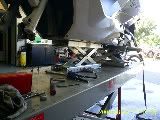Vectux = No Warranty, No Worries Vectrix!

.....................................
.....................................
As of today my scooter has done more Km's since I renamed it Vectux than as a Vectrix!
 Click here for a higher resolution picture.
Click here for a higher resolution picture.
And there has been a lot less trouble since then.
That makes this penguin very happy !

4999km total. (Plus about 1400km on the first Vectrix.)
2511km as Vectux, since the warranty was voided by Vectrix Australia.
2176km since the second, proper repair to the motor controller board.
1894km since I installed a Bussman fuse to replace the third blown Littelfuse. That is the longest distance I have ever covered on a Vectrix with one fuse....
I do not believe that riding up steep hills with a low battery had anything to do with the fuse failures as suggested by Vectrix Australia. The RETAMPI knows better...
............................
The RETAMPI continues to work fine, no problems with water entry so far.
It still displays the percentage of max. amps going in and out of the battery, peaking at 100 if the battery is full and warm, between 65km/h and 75km/h.
............................
The ABCool 12V power supply works beautifully and is into it's sixth version of charging / cooling pattern:
This pattern is suitable for when ambient temperatures are fluctuating daily between 10°C- 25°C, which happens in winter on the Australian Gold Coast. It does get a bit colder, but by the time I ride off to work it's usually above 10°C again.
It covers demanding, hilly and fast commuting, 20km x 2, including always charging at work.
I would not be able to get to work and back without a deep cycle of a fully charged battery or charging at work.
Timer 1 = Vectux charger:
2000 to 2130 Mo - Su
0900 to 1000 Mo - Fri
Timer 2 = AuxiliaryBatteryCooling:
1630 to 2000 Mo - Su
2130 to 1000 Mo - Su
0750 to 0900 Mo - Fri
1000 to 1100 Mo - Fri
These settings are supposed to achieve this:
A) Charge level remains between 25% and 90% most of the time.
B) It avoids unnecessary battery aging (due to avoidance of heating up during the later parts of charging and due to avoidance of deep cycling.)
C) Aims at stopping charging when "CP" has just finished.
D) Battery is cooled to about 20°C to 24°C before charging begins.
E) Battery is cooled after the charger has been turned off.
F) Energy wastage due to the chargers standby current consumption of 0.5A is avoided.
G) It might also increase the life span of the charger because the charger heats up if left plugged in once charging is complete, particularly in countries with higher grid voltages.
H) It reduces overall power consumption and increases the "Km/kWh" rate, because the later parts of the charging cycle, which are less efficient and produce a lot of heat rather than a lot of usable battery charge levels, are avoided.
A full recharge including "CC" and "tr" parts of charging to equalize cells will probably be done once every week or second week, when the full range is needed for some reason. I simply plug the Vectux "straight" into the grid instead of through the ABCool timers.
A BaLPoR will probably happen every few months, more or less when it is unavoidable.
I have only been testing this charging pattern for a few days so far, it might hold unexpected surprises....
Small changes to the charging times, to keep the battery levels within the wanted range, will probably be needed.
And the cooling times will need to go up once the weather gets warmer again.
.................
.................
The Vectux had new tyres fitted today.
The rear tyre could have gone for another 500-1000km before it would have become illegal, the front tyre a little longer, maybe 2000km. So I kept them, good spares for emergencies.
Whilst they wait for their comeback I'll grow fruit trees in them!
I replaced them with the same Pirelly tyres as the originals, about AU$140.- fitted.
This is how the Vectux was supported to get the front wheel out:
 Click here for a higher resolution picture.
Click here for a higher resolution picture.
....
 Click here for a higher resolution picture.
Click here for a higher resolution picture.
The front wheel is fixed to the fork in a standard way. It required 10g lead to balance, the same amount in the same spot as originally. That's good according to the tyre fitter.
The rear wheel, however, is a problem insofar that it does not fit onto a wheel balancing machine.
A custom Vectrix part would be needed to balance the wheel. This part would need to be perfectly balanced itself, and needs to attach perfectly centered to some or all of the six holes in the inner rim of the wheel. Not an easy feat to make that yourself!
So far I have not noticed any undue vibrations or wobble.
I made sure that the tyre fitter installed the wheel in the exact same position on the gearbox as before, by marking them. I was a bit worried that any small change could worsen the gearbox noise again, but so far it remained acceptable.
..........
..........
So far unsolved problems:
It remains to be seen what causes the "Disappearing 5 bars Syndrome".
A detailed computerised battery analysis is in progress and reported here.
So far it has shown that there are multiple cells with reduced capacity, which have also bulged. More about the uneven distribution here.
Almost all the low capacity cells are located in the lowest layer of 3 layers of cells. I believe the reduced capacity is due to radiant heat from hot road surfaces being transmitted to the lower cells.
I will probably paint the underside of the battery compartment with heat reflecting paint to prevent this from happening in the future.
Re-conditioning by controlled deep discharging of single cells shows most promising results so far, over 40% capacity increase for the weakest cell at 20A discharge rate.
.
The static thrust is limited too severely, much better acceleration should be possible.
.
A higher top speed could increase safety in some situations.
.
Software changes might be "all" that is needed to achieve these last two improvements.
.
Added on 2008-08-21:
A warning light to alert the rider to a rear/brake light failure needs to be added.
More details here.
Edited 2009-02-12: The hazard lights option has now been added to increase safety during low-battery crawls and other emergencies. It does not work during main fuse blow-outs, yet.
Mr. Mik
- Mik's blog
- Log in or register to post comments
Who's online
There are currently 0 users online.
Who's new
- eric01
- Norberto
- sarim
- Edd
- OlaOst





Comments
Re: Vectux = No Warranty, No Worries Vectrix!
Thanx for the report!
Re: Vectux = No Warranty, No Worries Vectrix!
Nice. Much easier to get to the subject.
When you had the batteries out of the bike did you by chance
happen to measure their physical dimensions?
Re: Vectux = No Warranty, No Worries Vectrix!
They are still out and will stay out for quite a while.
Hopefully I get it all back together before the end of the year.
It will have a much improved life expectancy, I hope, due to monitoring of individual cells and resulting protection from reverse charging and over-charging.
I'll measure their dimensions when I get a moment!
This information may be used entirely at your own risk.
There is always a way if there is no other way!